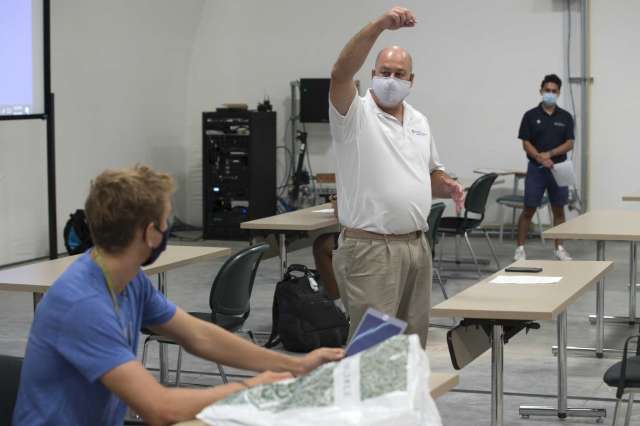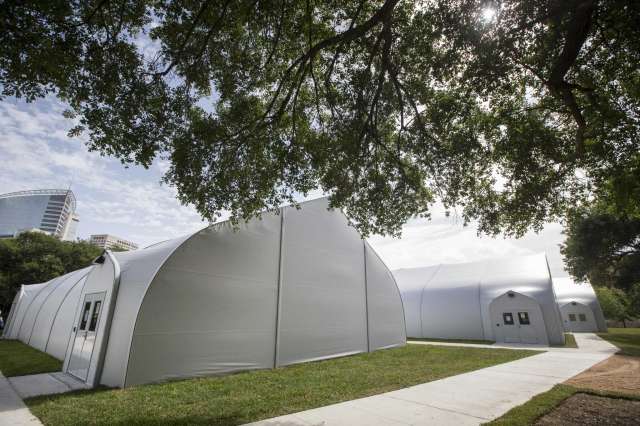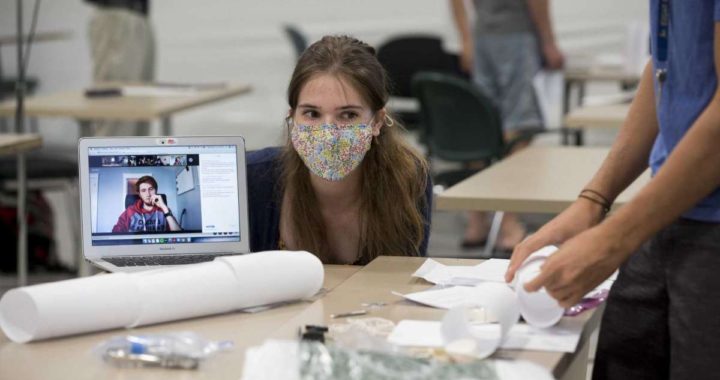Slider Photos: Brett Coomer, Houston Chronicle / Staff photographer
Brittany Britto
Houston Chronicle (Original Article)
September 11, 2020
When Rice University in Houston said it would construct outdoor classrooms for in-person fall courses, the announcement drew national attention with many wondering how students and faculty would handle the Texas heat.
But Rice had that, and more, covered.
Five large open-air archways, built by Utah-headquartered company Sprung Structures, provide shade in grassy areas on campus for people to congregate. And four 50-by-90-foot enclosed “high performance tensioned” fabric buildings serve as high-tech classrooms.
Fixed with doors and concrete floors, these semi-permanent, dome-like structures have full lighting; an audio and visual system, including projectors and cameras that can record, pan and zoom in on certain sections of the room for those learning remotely; and yes, air conditioning.
“This is a fantastic location for me,” said Rice engineering professor David Van Kleeck.
The new facilities for in-person classes are more spacious and have both better lighting and technology than the on-campus classrooms where he normally taught, Van Kleeck said.
“I’m extremely comfortable with what Rice has done to make it safe for us,” he said, adding that the university requires faculty members teaching in-person to be tested for coronavirus weekly with results coming in within 24 hours.
“I love being in the classroom with students. I can deal with Zoom stuff, but I like having one-on-one discussions.”
Students said they are also glad to be back inside a classroom working with others.
“I like the outdoor buildings. I think they’re a cool, controlled space to be in,” sophomore Emily Ellison said. “At first, I was wondering if it was a tent. Like, ‘what is that going to be like?’ But there’s a lot of technology. … It’s air-conditioned, which is a big deal. It’s a really cool space to work in.”
Freshman Juan Garza agreed, emphasizing the importance of being able to interact with others.
“You can still tell it’s the pandemic,” but as a freshman, Garza said, “I don’t know what I’m missing.”
There have been some modifications. Inside the sterile-looking structures, pandemic rules and complications still apply. Maximum occupancy is typically 51 people, but Rice has designated only 25 students are allowed inside each outdoor classroom. Masks and social distancing are still required, which can present some challenges, students and faculty said.

For example, in one engineering class, instead of the standard all-hands-on-deck approach for a group project, professors urged students to work together while staying 6 feet apart. The assignment: construct a device that would lower a ping pong ball to the floor in the allotted amount of time using school supplies.
Students got innovative — chiming in with suggestions through muffled masks and drawing pictures on computer paper and virtual whiteboards as one group member built a device.
Freddy Angarita, a sophomore transfer student, said the masks can make it difficult to hear.
And Ellison, who was working with one student in-person and three who were tuning in from Zoom, experienced challenges of her own. “It is hard to remember to keep our distance,” she said. “We had to be reminded, and it was a challenge making sure we could hear each other over Zoom.”
Ellison, however, remains optimistic.
“There’s a learning curve to it,” she said. “It’s going to take a bit more organization to get the kinks fine-tuned.”
And as faculty and students come up with new tweaks — like using a Bluetooth speaker for groups with a mix of in-person and remote students, or adjusting the sound system — many consider whether this could be a reality for schools moving forward.
“We should be doing this with every school in general,” said Jim Avery, a vice president at Sprung Structures, which built similar structures for Harvard Business School, Tesla in California and Tulane University long before the pandemic.
The fabric buildings are spacious, easy to clean, energy efficient, can be customized in days and built in weeks, Avery said. They can also cost up to half of what it costs to construct a brick and mortar building, he added.
Rice officials declined to comment on the cost of the outdoor structures.

Avery said he didn’t know the full cost of the Rice structures but estimated that one of the buildings could cost between $150 and $200 per square foot once systems like HVAC, audio and visual, lighting, insulation and more are installed. That means Rice’s structures could cost anywhere from $675,000 to $900,000 each and $2.7 million to $3.6 million in total — a hefty investment that some colleges might be hesitant to make.
Since the start of the pandemic, Avery said, there haven’t been many schools or universities building Sprung Structures on their campuses. Instead, he said, the company has seen requests from hospitals, homeless shelters and churches. But agreements with some colleges are in the works, he added.
“I think what we’re finding is that with a lot of schools with September start dates, they’re still trying to figure it out as it goes,” Avery said, but he’s confident that once colleges get better acclimated and assess their needs, the high-tech and easy-to-build structures could be the future.
“You really can’t lose,” he said.























